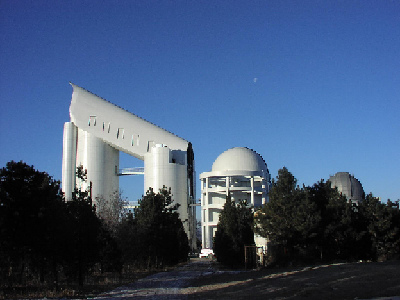
Cui's team innovatively designed 24 honeycomb-shaped flat thin plates to become the reflecting mirror. The bigger-sized primary mirror consists of 37 spherical hexagonal cells in a similar structure.
"A key innovation is an active optics system that deforms the correcting mirror's 24 plates individually, compensating for the spherical aberration of the primary mirror and bringing both mirrors into focus simultaneously," Prof. Cui said, calling it the active optics technique.
University of Chicago Prof. Donald York, who was the founding director of SDSS, said in an email interview with Xinhua, "LAMOST can do more than SDSS if they (Chinese astronomers) get high throughput for the entire system."
The game of scanning galaxies and stars is all about statistics, said Prof. York. "LAMOST has 4,000 fibers at a shot, 5.5 times that of SDSS and a bigger advantage over anything else."
SDSS, the 2.5-meter telescope, under multinational collaboration, which was installed in an astronomical station in New Mexico, the United States, images a sky area with the angular field of view of three degrees, equal to a size of 28 full moons. With five degrees in view, by comparison, LAMOST covers 80 full moons.
Prof. Richard Ellis, a California Institute of Technology (Caltech) astronomer who was invited by the CAS to advise on LAMOST, said in an email to Xinhua, "We still don't know exactly how deep LAMOST can probe but my guess is that it will outperform SDSS in both speed and depth."
LAMOST is dedicated to 100 percent spectroscopy whereas SDSS involves itself in both imaging and spectroscopy.
"In the case of LAMOST which is a spectroscopic telescope, targets must be found from some imaging surveys," the Caltech astronomer said. "This provides an immediate opportunity for international collaboration which will be beneficial."
As Cui's team wrapped up the engineering job, Chu Yaoquan, the LAMOST project scientist who is an astrophysicist at the University of Science and Technology of China (USTC) in Hefei, Anhui Province, would lead his team in scientific missions.
"We have yet to shape a clear idea about our galaxy's structure," Prof. Chu said. "By parsing spectra of millions of stars in the Milky Way, we would have a chance to get the whole history of the galaxy."
In addition, the scientific goal of LAMOST is likely to expand to extragalactic observation and multi-wave identification. Based on the data collected in phase II of SDSS, LAMOST is expected to push large sample spectroscopic sky survey deeper and wider.
Prof. York guessed that LAMOST would start by following up on SDSS before defining its own new mission. "It is important that it develops a scientific planning process that takes the best ideas and works very hard on a few big things," the astronomer said.
Chinese scientists have long considered capitalizing on the country's big astronomical facilities to make research breakthroughs.
The network of virtual observatories might be a wise way to utilize the survey capability of not only LAMOST, but also an on-duty 2.4-meter aperture telescope in Lijiang, Yunnan Province, and several smaller ones. Data-mining technologies would substantially help astronomers onto the fast track for pinpointing new finds in deep space.
Prof. York said observational breakthroughs are now coming from "finding out what is actually out there" rather than "using theory to predict what is out there".
(Xinhua News Agency November 5, 2008)